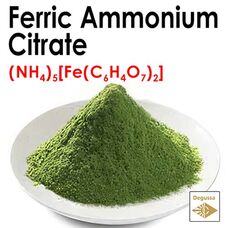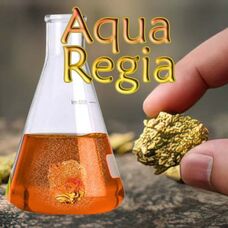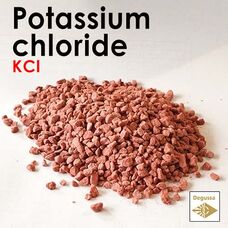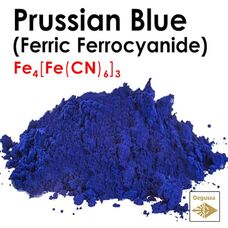Metal oxides are used in ceramics to produce color and effect
ALUMINUM POWDER - Pulvis Aluminum
Al Aluminum powder is a fine granular powder made from aluminum metal. It is commonly used in various industrial ap..
0.59€ 0.99€
Ammonium ferric citrate green - Iron ammonium citrate - the base material for making cyanotype prints
(NH4)5[Fe(C6H4O7)2] Ammonium ferric citrate is a chemical compound complex formed by the combination of iron (Fe³⁺)..
1.99€
Aqua regia - Regal Water Royal Water - The King's Water
Aqua Regia is a mixture of nitric acid and hydrochloric acid. Aqua regia is a fuming liquid. Freshly prepared aqua ..
19.99€
BARIUM HYDROXIDE: Unveiling Applications, Properties, and Industrial Significance - Barii Hydroxidum
Ba(OH)2 Barium hydroxide (Ba(OH)₂) is a chemical compound composed of barium, oxygen, and hydrogen ions. It is an a..
0.59€
BARIUM SULFATE - Unveiling the Versatility of Barium Sulfate: Properties, Applications, and Industrial Insights - Barii Sulfas
BaSO4 Barium sulfate (BaSO₄) is an inorganic compound that is commonly used in various industries for different pur..
0.59€
Cobalt Chloride: Pigments, Catalysts, Indicators, and Beyond
CoCl2 Cobalt (II) chloride anhydrous, also known as Cobaltous Chloride, is a beautiful sky blue color. It is genera..
2.99€ 3.99€
COBALT OXIDE - Cobalt (II,III) Oxide Cobalt Ceramic Pigments and Stains
Co3O4 Cobalt oxide color (Co3O4) is a consistent, reliable oxide and a common colorant in pottery. It is avai..
3.39€ 3.99€
Cobalt(II) phosphate - Cobalt Violet Cobalt Blue - Vivid and Saturated Colors
Co3(PO4)2 Cobalt phosphate is the inorganic compound with the formula Co3(PO4)2. It is a commercial inorganic..
2.99€
Iron(III) nitrate - Ferric nitrate Nonahydrate - Ferricum Nitricum
Fe(NO3)3 Ferric nitrate is a chemical compound with the formula Fe(NO3)3. It is a salt composed of iron..
1.19€
Lead Acetate - Lead(II) acetate trihydrate - chemical compound
Pb(C2H3O2)2·3H2O Lead(II) acetate (Pb(CH3COO)2), also known as lead acetate is a white crystalline chemical compoun..
0.99€
Lead(II) nitrate - Pb(NO3)2 - Lead Nitrate
Pb(NO3)2 Known since the Middle Ages by the name plumbum dulce, the production of lead(II) nitrate from either meta..
3.99€
Manganese Dioxide - Advantages of using in Pottery
MnO2 Manganese dioxide (MnO2) is an inorganic compound. It is a black to brown-colored material that occurs n..
0.99€
Potassium bromate (KBrO3)
KBrO3 Potassium bromate (KBrO3) is a chemical compound composed of potassium, bromine, and oxygen. It is a white cr..
1.99€
Potassium chloride - Red Potash
KCl Potassium chloride (KCl) is a chemical compound composed of potassium and chlorine. It is a metal halide salt t..
0.59€
Potassium chromate - K2CrO4
K2CrO4 Tarapacaite is the natural, mineral form of potassium chromate. It occurs very rarely and until now is known..
3.99€
Potassium dichromate - Potassium bichromate - K2Cr2O7
K2Cr2O7 Potassium dichromate, K2Cr2O7, is a common inorganic chemical reagent, most commonly used as an oxidizing a..
3.99€
Potassium Nitrate - Unlocking the Potential of Saltpeter: Applications and Benefits of Saltpetre
KNO3 Potassium nitrate, also known as saltpeter, is a chemical compound with the formula KNO3. It is a white, cryst..
0.99€
PRUSSIAN BLUE - Ferric ferrocyanide, Iron hexacyanoferrate - A Journey into Berlin Blue: History, Chemistry, and Applications
Fe4[Fe(CN)6]3 Prussian Blue is a deep blue pigment that has been used in various applications, including art,..
1.59€ 1.99€
Sodium dichromate - Natrii dichromas - Na2Cr2O7
Na2Cr2O7 Sodium dichromate is an inorganic compound with the formula Na2Cr2O7. However, the salt is usually handled..
3.99€
Strontium chloride - Exploring the Properties and Applications of Strontium Dichloride
SrCl2 Strontium chloride is a chemical compound with the molecular formula SrCl₂. It is composed of one stron..
9.99€
Tin(II) Chloride: Properties, Uses, and Applications of Stannous chloride
SnCl2 Tin(II) chloride, also known as stannous chloride, has the chemical formula SnCl2. It is a compound of tin in..
1.19€
TITANIUM DIOXIDE - Titanium(IV) Oxide Titanium White, Pigment White 6 (PW6) Pottery Pigment Stain Color Earthenware Stoneware Porcelain
TiO2 Titanium Dioxide (TiO2) also known as titanium(IV) oxide or titania. When used as a pigment, it is called..
0.59€
URANYL NITRATE, Uranium nitrate, Uranyl Nitrate Hexahydrate - a chemical compound of uranium
UO2(NO3)2 Please, note, that the product isn't in stock. It would be best if you preordered it. The time for ..
58.00€
UREA - Unlocking the Potential of Carbamide: From Agriculture to Industry urea
CO(NH2)2 Urea, also called carbamide (because it is a diamide of carbonic acid) is a chemical compound with t..
0.59€

























